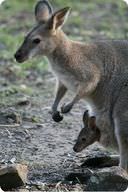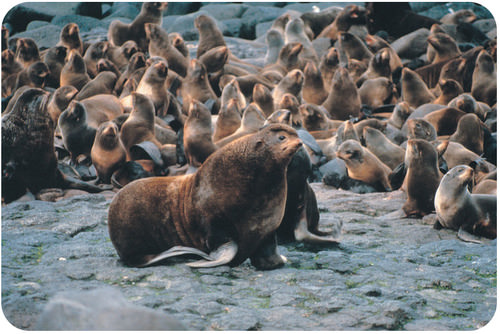10.21: Mammal Reproduction
- Page ID
- 14174

Do mammals lay eggs?
Could a rabbit really lay eggs? Rabbits are mammals, and most mammals do not lay eggs. Mammals usually give birth to live offspring. But there are some mammals that do lay eggs.
Mammal Reproduction
You probably realize that cats, dogs, people, and other mammals don't typically lay eggs. There are exceptions, however. Egg-laying is possible among the monotremes, mammals with birdlike and reptilian characteristics. Recall that mammals can be classified into three general groups, based on their reproductive strategy: the monotremes, the marsupials and the placental mammals.
The egg-laying monotremes, such as echidnas (Figure below) and platypuses (Figure below), use one opening, the cloaca, to urinate, release waste, and reproduce, just like birds. They lay leathery eggs, similar to those of lizards, turtles, and crocodilians. Monotremes feed their young by “sweating” milk from patches on their bellies, as they lack the nipples present on other mammals.

All other mammals give birth to live young and belong to one of two different categories, the marsupials and the placental mammals. A marsupial is an animal in which the embryo, which is often called a joey, is born at an immature stage. Development must be completed outside the mother's body. Most female marsupials have an abdominal pouch or skin fold where there are mammary glands. The pouch is a place for completing the development of the baby. Although blind, without fur, and with only partially formed hind legs, the tiny newborns have well developed forelimbs with claws that enable them to climb their way into their mother's pouch where they drink their mother's milk and continue their development. Marsupials include kangaroos, koalas, and opossums. Other marsupials are the wallaby and the Tasmanian Devil. Most marsupials live in Australia and nearby areas. (Figure below).
The majority of mammals are placental mammals. These are mammals in which the developing baby is fed through the mother's placenta. Female placental mammals develop a placenta after fertilization. A placenta is a spongy structure that passes oxygen, nutrients, and other useful substances from the mother to the fetus. It also passes carbon dioxide and other wastes from the fetus to the mother. The placenta allows the fetus to grow for a long time within the mother.

Some mammals are alone until a female can become pregnant. Others form social groups with big differences between sexes, such as size differences, a trait called sexual dimorphism. Dominant males are those that are the largest or best-armed. These males usually have an advantage in mating. They may also keep other males from mating with females within a group. This is seen in elephant seals (Figure below), and also with elk, lions and non-human primates, including the orangutans and gorillas. Male elk grow antlers, while female elk do not have antlers. Adult male lions are not only larger than females, they have a mane of long hair on the side of the face and top of the head.

Summary
- Monotremes can lay eggs, but most mammals give birth to live young.
- Mammals can be marsupial, where the embryo is born at an immature stage and develops in the pouch.
- Mammals can be placental, where substances are passed from the mother to the fetus so that it can stay longer in the womb.
Explore More
Use the resources below to answer the questions that follow.
Explore More I
- Marsupials at http://www.biokids.umich.edu/critters/Didelphimorphia/
- What are four examples of marsupials?
- Where are most marsupials found?
- What is the primary difference between marsupial and placental mammals? Explain your response.
Explore More II
- Marsupial Reproduction Process at http://www.youtube.com/watch?v=IloOJ3kc8us (4:06)
- How does parental care in marsupial mammals differ from parental care in placental mammals?
- Why do marsupials lick themselves during birth?
- How do scientists think marsupial babies find the pouch?
Explore More III
- Creation of Placenta at http://www.youtube.com/watch?v=I8sqaJVZRmo (3:51)
- What are two of the purposes of the placenta?
- What does the placenta allow to pass to the embryo?
- What does the placenta keep from the embryo?
- What is the function of the umbilical cord?
Review
- How are monotremes more like reptiles and birds than other mammals?
- What's the difference between marsupial and placental animals?
- What are three marsupials?
- Define and describe the role of the placenta.
- What is sexual dimorphism?

